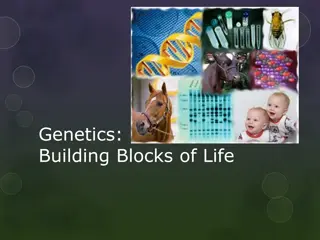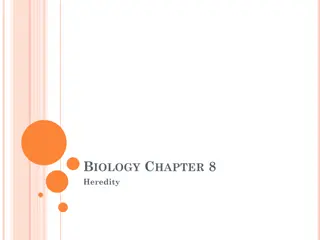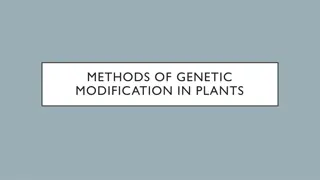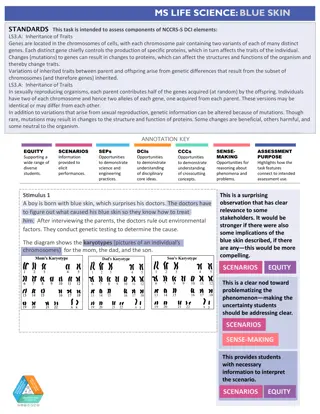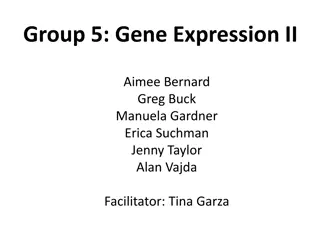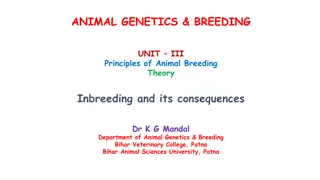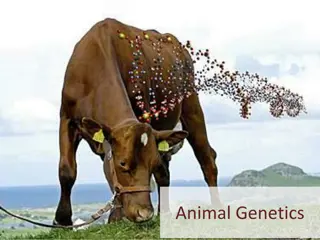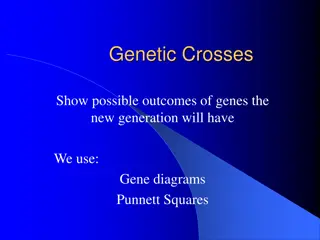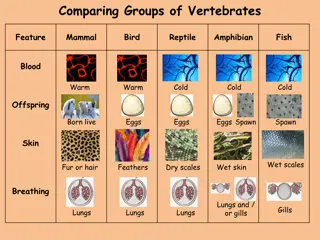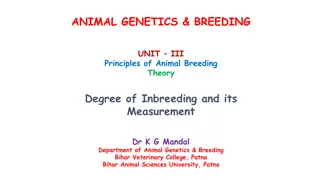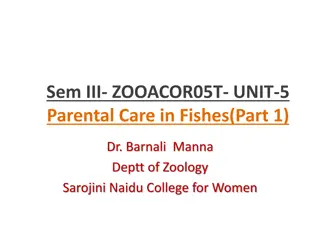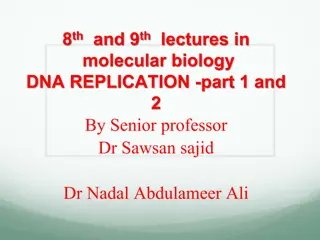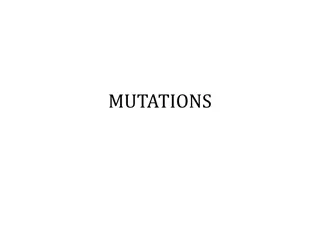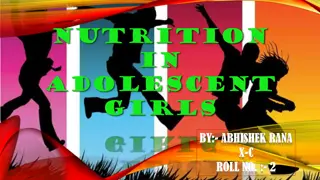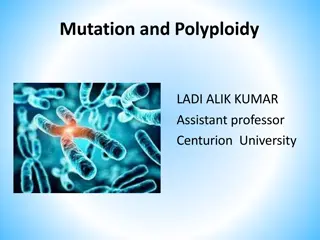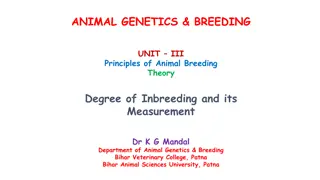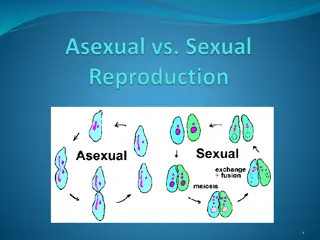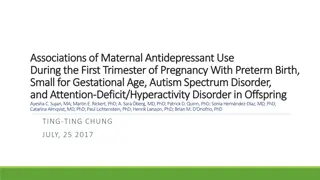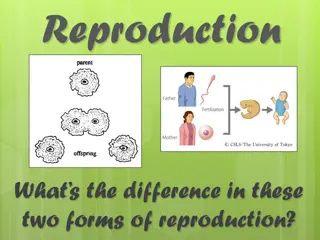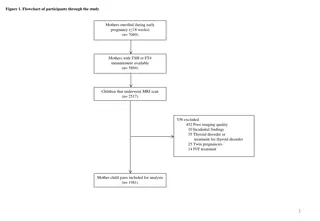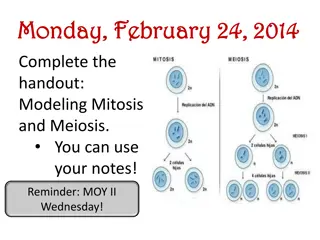Guide to Efficient Rodent Breeding and Colony Management
This comprehensive guide covers essential aspects of rodent breeding, colony management, and tips for successful rodent reproduction. It includes details on weaning, retiring breeders, records management, problem-solving, resources, goals and planning, breeding systems, reproduction processes, genot
4 views • 35 slides
Understanding Genetic Testing and Cancer Screening
Genetic testing involves the analysis of germline genes to determine the risk of developing certain cancers or passing on risks to offspring. It can provide valuable insights into cancer risks, help inform relatives about potential risks, but may have limitations and risks such as cost and insurance
0 views • 10 slides
Genetics: The Blueprint of Life
Genetics is the study of heredity and how traits are passed from parents to offspring. It involves understanding genetic makeup (genotype) and physical attributes (phenotype) determined by genes. Mendel's laws of segregation and independent assortment explain how alleles and traits are inherited. Nu
0 views • 34 slides
Understanding Mendel's Experiments and Principles of Genetics
Delve into the pioneering work of Gregor Mendel, the father of genetics, as he conducted groundbreaking experiments with pea plants, identified key principles of genetics, and introduced the concept of dominant and recessive traits. Explore how Mendel's work laid the foundation for our understanding
4 views • 23 slides
Different Methods of Genetic Modification in Plants
Genetic modification in plants can occur through natural selection, selective breeding, and induced mutations. Natural selection involves breeding compatible species to create offspring with desired traits, while selective breeding is a multi-generational process to breed organisms with specific cha
0 views • 11 slides
Understanding Inheritance of Traits Through Blue Skin Case Study
Assessing genetic inheritance and mutations using a case study of a boy with blue skin. The scenario highlights how genes control traits, the random assortment of chromosomes in offspring, and the impact of mutations on protein function. Students analyze karyotypes to infer genetic differences betwe
0 views • 6 slides
Epigenetics in Biology: Exploring the Impact of Parental Diet on Offspring Traits
Explore the fascinating world of epigenetics in biology through a focused unit on how parental diet can influence offspring traits. Dive into learning goals, outcomes, and a detailed tidbit outline that includes activities and resources for understanding the molecular mechanisms behind these effects
0 views • 21 slides
Understanding Inbreeding and Its Consequences in Animal Genetics & Breeding
Inbreeding in animal breeding involves mating closely related individuals, resulting in common ancestors within the preceding generations. This practice can have both positive and negative consequences on genetic diversity and health. Various types of inbreeding such as selfing, full-sib mating, and
0 views • 18 slides
Understanding Animal Genetics: A Comprehensive Overview
Animal genetics is the study of heredity, inheritance of traits from parents to offspring, genetic material like DNA, chromosomes, genes, alleles, and nucleotides. It involves the understanding of chromosomes in different livestock species, DNA as the carrier of genetic information, genes as units o
0 views • 67 slides
Unraveling the Mystery of Traits and Genes
Explore the fascinating world of traits and genes, understanding how they are passed down from parent to offspring through chromosomes. Delve into the role of genes in controlling various traits such as hair color, eye color, and even unique characteristics like detached earlobes and widow's peak. D
0 views • 11 slides
Understanding Genetic Crosses and Inheritance Patterns
Discover the world of genetic crosses through gene diagrams and Punnett squares. Explore the terminology, genotype, phenotype, and the concepts of dominance and recessiveness. Learn how genes control characteristics like eye color, delve into allele combinations for flower color, and see possible ou
0 views • 15 slides
Comparing Groups of Vertebrates: Features and Differences
Explore the key characteristics of five groups of vertebrates - mammals, birds, reptiles, amphibians, and fish - including details on blood type, offspring, skin, and breathing apparatus. Learn about the unique traits that distinguish these vertebrate groups from one another.
0 views • 4 slides
Understanding Degree of Inbreeding in Animal Genetics and Breeding
Degree of inbreeding refers to the extent to which an individual carries genes identical by descent. This concept is crucial in animal breeding as it affects genetic diversity and homozygosity in offspring. The coefficient of inbreeding is used to measure the level of inbreeding, with higher values
1 views • 30 slides
Vertebrate Reproductive Strategies and Success Factors
Vertebrates exhibit various reproductive strategies to ensure reproductive success, such as external and internal fertilisation, ovipary, vivipary, and ovovivipary. The ultimate goal of each species is to maximize the number of surviving offspring while conserving energy. Different terminologies rel
1 views • 10 slides
Understanding Reproduction: Pollen, Eggs, and Life Cycles in Plants
Reproduction in plants involves the transfer of pollen to eggs, leading to fertilization and the formation of new life. Male animals produce sperm, while females produce eggs, which fertilize when they meet. Different animals exhibit external or internal fertilization, with varying numbers of offspr
1 views • 13 slides
Parental Care in Fishes: Importance and Diversity
Parental care in fishes is an instinctive behavior that ensures offspring survival and reproductive success. It can be provided by males, females, or both parents, with different types of care strategies such as maternal care, biparental care, and various methods of protecting eggs and young. The co
2 views • 19 slides
Insights on Parenting by Sir Francis Bacon
Sir Francis Bacon's essay "Of Parents and Children" offers thought-provoking insights on parenting, advocating for parents to guide their children in choosing a profession rather than solely relying on the child's interests. Bacon highlights the joys and griefs of parenthood, emphasizing the respons
0 views • 20 slides
Understanding DNA Replication Process: Insights and Mechanisms
DNA replication is a crucial biological process where identical copies of DNA molecules are produced for cell division. Initiated by specific proteins, it involves stages like initiation, elongation, and termination. Enzymes like helicases and DNA polymerase play key roles in forming replication for
0 views • 33 slides
Understanding Expected Progeny Differences (EPDs) in Beef Cattle Selection
Expected Progeny Differences (EPDs) in beef cattle breeding predict future offspring performance based on genetic merit. They help compare animals as parents and aid in selecting for traits like birth weight, weaning weight, and yearling weight. Combining EPDs with visual appraisal improves decision
0 views • 15 slides
Exploring the Future of Medicine: Genetics, Innovations, and Debates
Delve into a captivating journey through the realms of genetics, medical innovations, and thought-provoking debates surrounding designer babies. Discover the evolution of healthcare, from insulin pumps to genetic design, and ponder the ethical implications of shaping offspring through genetic engine
0 views • 13 slides
Understanding Average Gene Effect and Breeding Value in Animal Genetics
In the field of animal genetics and breeding, it is crucial to comprehend the average effect of genes and breeding value of individuals. Genes are transmitted from parents to offspring through haploid gametes, influencing the genotype and breeding potential. Estimating the average effect of a gene i
4 views • 26 slides
Understanding the Composition of Milk by Dr. Sanjeev Kumar
Milk, a vital substance for mammalian offspring, is a complex fluid composed of water, fat, protein, lactose, minerals, vitamins, and enzymes. Dr. Sanjeev Kumar, an Associate Professor and Head of the Department of Dairy Technology at SGIDT, enlightens us on the various constituents of milk, market
0 views • 11 slides
Understanding Mutations in Biology
A mutation in biology refers to changes in the nucleotide sequence of an organism's genome. These alterations can either be harmful, leading to conditions like cancer, or beneficial, such as providing antibiotic resistance. Mutations can occur in somatic cells or gametes, affecting both the individu
1 views • 18 slides
Importance of Nutrition in Adolescent Girls
Adolescence is a crucial period where proper nutrition plays a vital role in supporting physical growth and preventing future health issues. Nutritional deficiencies during this time can impact a girl's development and may have repercussions on her future health and that of her offspring. Understand
0 views • 9 slides
Understanding Mutation and Polyploidy in Genetics
Mutation is a sudden hereditary change in an organism's genetic makeup, leading to variations in offspring. This article delves into the history, types, and causes of mutations, featuring significant discoveries by scientists like De Vries and Morgan. It also explores the concept of spontaneous muta
0 views • 50 slides
Understanding Degree of Inbreeding and its Measurement in Animal Genetics and Breeding
Degree of inbreeding in animals is the extent to which genes are identical by descent within an individual. The coefficient of inbreeding, denoted by F, measures this degree and represents the increase in homozygosity in offspring from closely related matings. Two sources of homozygosity are genes a
0 views • 15 slides
Understanding Gene Mutations in Molecular Biology
Gene mutations play a significant role in molecular biology, leading to alterations in DNA sequences that can impact offspring. These mutations can arise spontaneously or be induced by various factors, such as mutagens. Understanding gene mutations is crucial for comprehending the genetic basis of c
2 views • 27 slides
Diverse Parental Care in Amphibians - An Insightful Overview
Amphibians, including anurans, urodelans, and apodans, exhibit a variety of parental care strategies to protect their eggs and offspring. From nest construction to direct nursing, different species showcase unique behaviors to ensure the survival of their young. Explore the fascinating world of pare
0 views • 34 slides
Understanding Asexual Reproduction in Organisms
Asexual reproduction requires only one parent, resulting in offspring that are exact clones of the parent, with the same DNA and chromosomes. This method is common in one-celled organisms and involves processes like binary fission, plant cuttings, budding, fragmentation, and regeneration. Various or
1 views • 13 slides
Understanding ABO Blood Grouping and Rh Groups
ABO blood grouping and Rh factor testing are crucial for blood transfusions and forensic medicine. The presence or absence of specific antigens and antibodies in human blood determines blood type. Genetic inheritance from parents establishes blood type, with codominance influencing offspring phenoty
0 views • 13 slides
Understanding Punnett Squares for Predicting Offspring Genotypes
Punnett squares are a visual tool used to predict the possible genotypes and phenotypes of offspring based on the parent's genetic makeup. By following simple steps and understanding dominant and recessive traits, you can calculate the likelihood of different genetic outcomes for traits like hair co
0 views • 7 slides
Understanding Meiotic Cell Division and Sexual Reproduction in General Biology
Meiosis is a crucial process in sexually reproducing organisms where cells divide to produce sex cells with half the normal number of chromosomes. This ensures genetic variation in offspring. Meiosis takes place in specific cells of an organism with paired chromosomes (diploid cells), leading to the
0 views • 18 slides
Understanding Reproductive Modes: Asexual vs. Sexual
Reproduction can occur through asexual or sexual means, each with its distinct processes and outcomes. Asexual reproduction involves only one parent and produces genetically identical offspring, while sexual reproduction involves the fusion of specialized sex cells from two parents to create genetic
1 views • 46 slides
Associations of Maternal Antidepressant Use During Pregnancy with Offspring Outcomes
Prenatal antidepressant exposure during the first trimester of pregnancy is linked to various adverse outcomes in offspring, including preterm birth, small for gestational age, autism spectrum disorder, and attention-deficit/hyperactivity disorder. This study evaluates the associations and alternati
0 views • 28 slides
Maternal Effect on Shell Coiling in Snails
Maternal effects play a crucial role in determining the coiling direction of snail shells. The maternal inheritance of organelle genes controls certain traits in offspring, with the direction of shell coiling being a classic phenotype exhibiting maternal effects. The genotype of the female parent de
0 views • 7 slides
Reproduction in Organisms: A Comparison of Sexual and Asexual Methods
Reproduction in organisms involves two main methods - sexual and asexual. In sexual reproduction, two parents contribute genetic information, leading to unique offspring, while asexual reproduction involves a single parent producing genetically identical offspring. This article explores the differen
0 views • 16 slides
Understanding Types of Reproduction in Organisms
Organisms reproduce through asexual and sexual reproduction methods. Asexual reproduction involves one parent and produces uniform offspring, like in binary fission, budding, and regeneration. Sexual reproduction involves two parents and results in offspring with varied traits. Both methods have the
0 views • 24 slides
Asexual Reproduction and Passing of Traits
Asexual reproduction involves cell division to create genetically identical offspring. This process includes binary fission, budding, fragmentation, and vegetative growth. Offspring produced through asexual reproduction inherit traits directly from the parent organism. Understanding asexual reproduc
1 views • 24 slides
Maternal Thyroid Hormones and Offspring Brain Development: Study Flow and Findings
This study examined the association between maternal thyroid hormones (TSH and FT4) during early pregnancy and offspring brain morphology. A flowchart illustrates participant enrollment and exclusion, with subsequent MRI analyses on child brain volumes. Results show significant associations between
0 views • 4 slides
Understanding Genetics: Mendel's Experiments and Inheritance Patterns
Delve into the world of genetics through Mendel's groundbreaking experiments with pea plants, exploring traits inheritance, Punnett squares, dominant and recessive alleles, incomplete dominance, and co-dominance. Gain insights into how traits are passed from parents to offspring and predict offsprin
0 views • 9 slides


